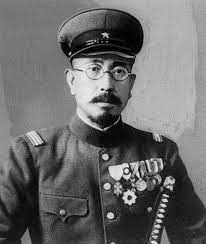Alex Constantine - May 4, 2013
 Shiro ishii
Shiro ishii
Among the unremarkable apartment blocks of Ping Fan, an unremarkable suburb of Harbin, sits an unremarkable low brick building, muted against the snow. This is 731. The base of Unit 731, home to some of the worst atrocities in this part of China during World War II, a place where men, women, babies and children were infected with hideous diseases then dissected – alive, and without anaesthetic, because either mercy killing or anaesthesia might affect the state of the organs the doctors wanted to inspect.
The doctors, scientists and soldiers at Unit 731 froze people alive, limb by limb, allowing frostbite to develop, then gangrene, amputating the gangrenous section of the limb, then repeating the process with the living stump, and moving onto the next limb, until all that remained of the victim was a head and torso.
On the waste not, want not principle, they’d then inject the traumatised, limbless victim with bubonic plague, and dissect them alive to track its progress.
At Unit 731 doctors watched as a mother in a gas chamber threw herself over the body of her baby to try and save him, and took careful notes as human beings were compressed in a pressure chamber until their eyes popped from their skulls.
You’ve heard of Josef Mengele.
But you’ve probably never heard of Shiro Ishii, a medical doctor, a distinguished professor, a genius microbiologist with a photographic memory, a decorated soldier, a Lieutenant-General in the Imperial Japanese Army, and the man behind Unit 731.
Emperor Hirohito, the father of Japan’s current emperor, Emperor of Japan both during World War II and until his death in 1989, established Ishii’s unit by Royal Decree, met him at least twice and almost certainly monitored his progress carefully.
Every nation has its own perspectives on the war that shaped and defined the last century.
In England, World War II is a heroic solo battle against Hitler’s armies as an isolated island; in the US, it’s a gallant and voluntary intervention to save Europeans from their own problems. In both nations, there’s a firm and erroneous belief that, while the Red Army engaged in mass rape in Berlin, our own troops didn’t.
In Russia, the focus is on the Great Patriotic War, a war in defence of the motherland that started in 1941. In China, it’s the People’s War Against Japanese Aggression, and it started in 1937 – although Japan occupied this part of China in 1931, and installed a puppet government led by the “Last Emperor”, Pu Yi.
In Japan… Well, the Japanese government didn’t acknowledge Unit 731′s activities until a scant few years ago, and has never paid compensation or contributed to the chemical weapons clean-up. Many Japanese nationalists deny wartime atrocities and pay tribute to convicted war criminals at a sacred shrine: the current Prime Minister Abe has repeatedly hinted that he will do likewise.
Ishii swore his staff to silence. Many of his team went onto stellar careers in pharmaceuticals and even medicine after the war. A bare handful of the men who worked at Unit 731 have expressed their deep regret for the things they did; others have said they’d do the same again.
It’s a surprisingly muted place, Unit 731. In a time of rhetoric between a nationalist Japan and a resurgent China, of competition over oil and islands, the tone is calm, almost dry.
Sombre galleries explore the beginning of Japan’s chemical and biological weapons programme, “inspired”, so to speak, by the trenches of World War I, lay out maps of facilities, recreate scenes in muted silver sculptures, lay out rooms of instruments salvaged from the site.
The focus, here, is on Chinese suffering. No mention of the Russians and Mongolians who died, of the American POWs deliberately infected with disease at Mukden: the names of the dead recorded here are all Chinese.
When the Japanese retreated from Manchuria, they blew up as many of these bases as they could. But not all.
And the world knew. The Russians knew. The Chinese knew. Truman knew.
So, in a world where even the men behind S-21 have finally gone to trial, why have most of us never heard of Shiro Ishii?
In Ishii’s world, the Japanese military code dictated death rather than surrender, the Emperor was a living god and, thanks to the same sense of racial superiority that helped dehumanise 731′s victims to the degree that the men who mutilated and murdered them referred to them as “logs”, Japan could not lose the war.
So when Hirohito surrendered, Ishii was so distraught that he experienced what seems to have been a nervous breakdown.
Not that that stopped him bringing his data back to Japan, hiding it, then faking his own death – until the US caught up with him in 1946.
Ishii’s crimes were not the issue. A war crimes trial would have put the fruit of his labours on open view. And, unlike Mengele’s torture-murders, Ishii’s had genuine value: they had produced a treatment for frostbite, a series of vaccines and, what was of most interest to his captors, the foundations of a world class biological weapons programme.
And, as the US had only started its biological weapons programme in 1942, the military was desperate for Ishii’s data. So Ishii negotiated immunity from prosecution for himself and every one of his subordinates in exchange for the painstakingly detailed notes of every single murder they had committed, for photos of the diseased organs of vivisected children, for records of the most effective systems for delivering both chemical and biological weapons.
And, of course, they got it. As well, apparently, as money, gifts and “entertainment”.
Which is why you’re unlikely to have heard of Shiro Ishii.
The man who had overseen the live dissections of infants and pregnant women without anaesthetic, who had killed tens of thousands with bubonic plague and typhoid, lived peacefully in Tokyo until 1959 on his army pension.